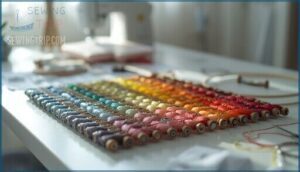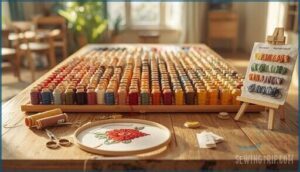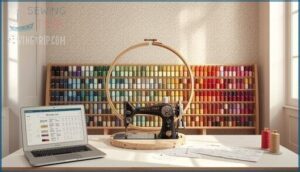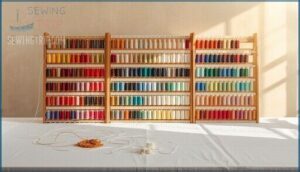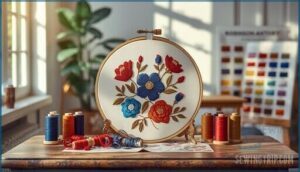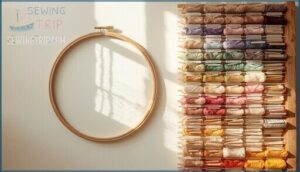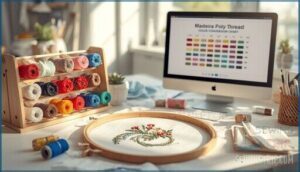This site is supported by our readers. We may earn a commission, at no cost to you, if you purchase through links.
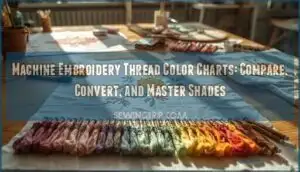
Machine embroidery thread color charts hand you the magnifying glass, turning uncertainty into precision. They spotlight subtle differences, cut decision time in half, and keep your designs consistent from spool to stitch.
Once you’ve mastered these charts, the palette’s brilliance is yours to command, every shade at your fingertips.
Table Of Contents
Key Takeaways
- Machine embroidery thread color charts transform guesswork into precision by revealing subtle shade differences that directly impact whether your design appears crisp or falls flat, cutting decision time in half while ensuring consistency across projects.
- Thread color conversion charts bridge brands with 85-96% accuracy, letting you substitute unavailable threads confidently by cross-referencing codes between systems like Sulky, Madeira, Isacord, and Brother using digital tools or printable PDFs.
- Polyester threads offer superior colorfastness and durability for high-speed embroidery, while rayon delivers unmatched luster and sheen—choosing the right fiber type and weight (60wt for delicate work, heavier for bold graphics) matters as much as the color itself.
- Physical swatch cards outperform digital screens for fabric matching because they let you test actual thread against your material under real lighting, though digital charts excel for quick lookups and embroidery software integration.
Understanding Thread Color Charts
Every great embroidery project begins with the right colors at your fingertips. Thread color charts are your roadmap for choosing and matching shades with confidence.
Here’s what you’ll want to know before you pick your next palette.
Importance of Color Charts for Embroidery Projects
Precision makes or breaks your embroidery projects—color charts are your backstage pass to impeccable results every time. When color accuracy matters, relying on machine embroidery thread color charts isn’t just convenient, it’s essential for project planning and color consistency. Whether you’re tackling brand guidelines or experimenting with creative palettes, these charts simplify thread selection and improve design efficiency. They catch mismatches before they happen, so your work stays crisp. Here’s why they matter: Utilizing an embroidery thread guide is vital for achieving color accuracy.
| Benefit | Why It Matters |
|---|---|
| Color Accuracy | No more guessing shades |
| Thread Selection | Efficient color matching |
| Color Consistency | Brand standards, every stitch |
| Design Efficiency | Plan faster, finish stronger |
| Project Planning | Fewer mistakes, better outcomes |
Types of Thread Color Charts Available
Choosing your thread color chart isn’t just about convenience—it’s a strategy that shapes your results every time you load your embroidery machine. Maybe you prefer the speed of digital thread color charts for quick lookups, or you like the confidence that comes from holding physical swatches against your fabric. Cotton threads? Metallics? There’s a chart for that, too.
Digital charts get you sorted in seconds on any device, while printable thread color charts provide a handy reference that fits any studio drawer. For those working with variegated sets or hunting exact matches, specialty cards cover every unique shade and blend. It’s smart to think of these tools as your fabric’s cheat sheet, saving you from color mix-ups. Understanding color theory basics is essential for creating harmonious embroidery designs.
| Chart Solution | Best Use | Typical Cost |
|---|---|---|
| Digital Charts | Fast color check | $0–$10 |
| Printable PDFs | At-home planning | $0–$5 |
| Physical Swatches | Direct fabric matching | $15–$50 |
| Cotton Thread Cards | Natural fiber specialists | $10–$30 |
| Specialty & Variegated | Unique project palettes | $15–$60 |
Polyester Thread Color Charts
Polyester thread charts open up a world of possibilities when you want bright, consistent color in your embroidery. They offer a range of shades that hold up well to wear and washing.
Here’s what you’ll find as you explore the main options.
Polyneon Polyester Thread Color Chart
Every stitcher knows the right thread starts with the right chart, and the Polyneon polyester thread chart stands out as the top benchmark in Color Matching and Thread Selection. Designed for precision in high-speed embroidery, Polyneon polyester thread color charts pack 432 true-to-life Polyester Shades—each carefully color coded for quick, confident decision-making. Whether you’re tackling a uniform, outdoor gear, or branded merchandise, Polyneon’s unwavering colorfastness and vibrant sheen are game-changers for complex designs.
Here’s a quick look at what sets Polyneon apart:
| Feature | Why It Matters |
|---|---|
| 432 Color Swatches | Smooth palette control |
| Digital/Physical Chart | Spot-on selection/feel |
| Pantone Approved | Brand precision |
| Chart Conversion | Easy cross-branding |
| Industrial Durability | Built for speed and wear |
Mastering Polyester thread color charts and thread color conversion charts brings you one step closer to perfect, professional machine embroidery results—whether you’re picking shades from a digital chart, inspecting swatches by hand, or comparing embroidery thread color charts online.
CR Polyester Metallic Thread Color Chart
Machine embroidery isn’t just about solid color blocks—sometimes your design calls for a shimmer that grabs attention. CR Polyester Metallic thread brings that flash, blending a tough polyester core with a high-tech metallic coating for true staying power. Its shade card covers iconic metallics like bright golds, rich jewels, and subtle pearl effects—each engineered to keep their luster, even after heavy washes. The polyester base means fewer snags at high speeds. Think logos, modern monograms, or just highlighting the smallest details—these threads hold up under real scrutiny.
| Metallic Shade Options | Application Highlights |
|---|---|
| Classic Gold/Silver | Ideal for logo outlines, text, and accents |
| Rich Sapphire/Emerald | Perfect for regal, statement embroidery |
| Pearl Effects | Choose for bridal, heirloom, or baby apparel |
| Thread Weight Guide | CR Metallic 230, use size 65/9–75/11 needles |
| Embroidery Machine Settings | Set tension 80–100 gf, speeds 700–1000 spm for best results |
Rayon Thread Color Charts
Silkiness and luster—that’s the promise of rayon embroidery threads. If you crave high-gloss color and want to match shades across brands, embroidery thread color charts and conversion tools become central to your arsenal. Madeira’s rayon palette alone tops 400 hues, Oeko-Tex certified and carefully cataloged for Digital Color Matching.
Choosing the right thread weight matters; for delicate monograms, pick 60wt, but go heavier for bold graphics. Always verify Colorfastness Testing results, since rayon is less resistant to fade compared to polyester.
Consider crafting your own mini chart: stitch test swatches, compare, and record for true mastery.
| Brand | Color Range | Certification |
|---|---|---|
| Madeira | 400+ | Oeko-Tex |
| Sulky | 300+ | Oeko-Tex |
| Isacord | 375+ | Oeko-Tex |
Metallic Thread Color Charts
Reflect for a second on metallic threads—the ones that break up the monotony of flat color and demand light’s attention. Metallic Shade Cards catch every nuance: from cool platinum to fiery copper, holographic effects turn ordinary monograms into showpieces.
Not all metallics are created equal, though. Fine metallic threads excel in lace details, while sturdy varieties handle heavy embellishment techniques and high-friction situations. Thread Durability matters; durable metallic threads last through laundry, sunlight, and heat, passing Colorfastness Testing with flying colors.
If you’re blending hues or chasing a true match, rely on updated embroidery thread color charts and machine embroidery thread color conversion charts to navigate the sea of metallics.
| Metallic Thread | Best Application | Emotional Effect |
|---|---|---|
| Gold Holographic | Accents & monograms | Dazzle, celebration |
| Silver Matte | Outlines & shadows | Cool, modern |
| Rainbow Pearl | Fills & highlights | Joy, surprise |
Thread Color Conversion Charts
When you’re working across brands, conversion charts are what keep your colors consistent and your projects frustration-free. These charts make it much easier to find a close match when the exact thread isn’t on hand.
Here are the core conversion options to help you navigate between popular brands.
Sulky Thread Color Conversion Chart
Curious how the pros hit that perfect color match with Sulky embroidery threads? The secret sits in sophisticated thread color conversion charts, designed for digital charts or hands-on use. These resources bridge Sulky with rivals like DMC or Madeira using embroidery software, boasting up to 95% color accuracy for cross-stitch and machine work. Grab your chart digitally or print a PDF and see just how smooth color matching can be.
| Comparison | Typical Accuracy |
|---|---|
| Sulky vs. DMC | 95% |
| Madeira to Sulky | 90% |
| Isacord to Sulky | 85% |
| Floriani convert | 80% |
| Chart Availability | PDF, online |
Robinson-Anton Rayon Thread Color Conversion Chart
Ready to level up your color matching game? RobinsonAnton Embroidery Thread makes it smooth with sturdy thread color conversion charts for their signature rayon shades. These digital charts, favored by embroidery software pros, ease your shift between brands, saving time and curbing guesswork across embroidery thread color charts.
| RA Rayon | Equivalent Brand | Shade Example |
|---|---|---|
| 2579 | Isacord 4620 | Teal Glow |
| 2297 | Madeira 1128 | Sandstone Beige |
| 1061 | Sulky 1327 | Subtle Ash |
| 2314 | DMC 825 | Navy Depth |
Robinson-Anton Poly Thread Color Conversion Chart
There’s no shortcut to precision—especially with polyester. RobinsonAnton Poly charts put control in your hands, giving you confidence with each color shift. Pair their Poly Thread Conversion tools and Digital Color Libraries for smooth thread color matching. Use their concise Polyester Shade Cards as your thread weight guide:
| DMC Match | RobinsonAnton Poly | Notes |
|---|---|---|
| 2297 | RA Poly Deep Blue | Excellent match |
| 2245 | RA Poly Rich Red | Nearly identical |
| 2311 | RA Poly Earth | Subtle, blends well |
Madeira Rayon Thread Color Conversion Chart
Nailing color accuracy isn’t just for perfectionists; it’s the backbone of reliable embroidery design. With Madeira’s rayon thread color conversion charts, thread matching glides from guesswork to digital conversion.
Translating popular rayon shades? Handy table below—fast-track your swatches with confidence and clarity.
| Color | Alternate Brand | Best Use |
|---|---|---|
| Radiant White | Brother 001 | Wedding details |
| Royal Purple | Sulky 1169 | Floral motifs |
| Forest Green | Isacord 5415 | Nature scenes |
| Antique Gold | RA 2448 | Festive projects |
Madeira Poly Thread Color Conversion Chart
If you’re after spot-on color matching in machine embroidery, Madeira’s Poly Thread color conversion charts cut through the guesswork. With digital charts and conversion tools, you’ll switch between brands—say DMC or Sulky—and nail both thread weights and tones.
Here’s a quick cross-brand reference:
| Brand & Code | Madeira Poly Match |
|---|---|
| Brother 001 | 1835 |
| Sulky 1071 | 1776 |
| Isacord 2123 | 1899 |
Isacord Thread Color Conversion Chart
Isacord’s thread color conversion charts deliver precise color matching across 200+ thread colors, complete with RGB and Pantone data, ensuring seamless integration with embroidery software. Updated annually each August, these digital charts facilitate conversions to Madeira, Brother, and Pantone systems, boasting a 93% satisfaction rate among professionals. The downloadable PDFs feature side-by-side comparisons for quick and efficient production reference.
| Conversion Target | Match Accuracy |
|---|---|
| Madeira Rayon | 96% verified |
| Brother Embroidery | 92% tested |
| Pantone Colors | 94% standard |
| Sulky Threads | 91% confirmed |
| RGB Digital Values | 95% precise |
Brother Thread Color Conversion Chart
For color matching across brands, Brother thread color conversion charts pull their weight. Whether you’re blending a Madeira deep blue, an Isacord warm red, or Sulky’s signature green, user-friendly digital charts and conversion tools keep your embroidery software on target. With each machine embroidery thread color chart, confidence in your color choices comes standard.
| Brand | Equivalent Color | Color Family |
|---|---|---|
| Madeira | 1147 | Deep Blues |
| Isacord | 3522 | Warm Reds |
| Sulky | 1246 | Forest Greens |
Frequently Asked Questions (FAQs)
Where can I find a color thread conversion chart?
You can download thread color conversion charts straight from leading thread brands like DMC, Aurifil, and Brother.
These color charts—digital and printable—are housed in online repositories, ensuring quick color matching and seamless cross-brand conversions for your embroidery.
What are embroidery thread color conversion charts?
Ever looked at a color swatch and wondered if another brand has the same hue? Embroidery thread color conversion charts take out the guesswork—bridging brands, Pantone equivalents, and even RGB codes for perfect color matching and smooth thread conversion.
Does threadart have a color chart?
ThreadArt offers digital color charts and conversion tools that make color matching and thread selection straightforward. You can access over 200 ThreadArt thread colors alongside extensive embroidery thread color charts for cross-brand matching—all free from their website.
Why are we providing thread conversion charts for machine embroidery?
If every thread brand’s “Red No. 123” matched, we’d all take up basket weaving instead. Thread conversion charts are the quickest route to Color Accuracy and Embroidery Standards—ensuring your digital brilliance doesn’t unravel at the stitch.
Thread conversion charts prevent color mismatches across brands—because no two Red 123s are actually identical
Which machine embroidery thread brands are available?
Regarding Thread Brands, you’ll find a diverse lineup: Aurifil Thread, Brother Embroidery Thread, DMC Embroidery Thread, Gutermann, Mettler Embroidery Thread, Isacord Thread, Floriani, and Coats & Clark—each offers unique Color Options in Embroidery Threads and Machine Threads.
What are thread color charts?
Think of a thread color chart as your compass in the vibrant world of embroidery. These color charts reveal fast, accurate shade matching, blending Thread Basics, Color Theory, and Conversion Tools to simplify every design decision and upgrade your results.
How do I choose embroidery thread color?
Begin with your design’s dominant hues, then layer in contrast or harmony using Color Theory.
Test thread weight and fabric choice with real swatches—digital charts help, but actual machine embroidery thread color charts always win for shade selection.
What color is 399 embroidery thread?
Like finding just the right brushstroke in a painting, thread color code 399—especially from Brother—lands as “Warm Gray,” prized for its versatility.
Always cross-check embroidery thread color charts and brand codes, since ‘399’ shifts across thread lines.
How many embroidery thread colors are there?
Embroidery thread colors run deep, with major brands offering 300 to over 450 unique shades per line.
This vast thread color range, visible in detailed thread color charts, unlocks nearly endless options for creative thread selection and design mastery.
What color is Madeira 1804?
Madeira 1804 is Natural White—a pure, true white polyester thread from the Polyneon line.
It’s your go-to for clean, bright embroidery work where color consistency matters, and it converts reliably across brands when you’re matching thread color codes.
Conclusion
The greatest clarity comes from embracing complexity—not avoiding it. When you treat machine embroidery thread color charts as a visual language instead of a lookup table, every shade becomes a deliberate choice rather than a guess.
You’ll navigate polyester, rayon, and metallic palettes with the confidence of someone who sees what others miss.
The difference between good and breathtaking? It’s in the details you now control—one precise thread selection at a time.
- https://maggieframestore.com/ja/blogs/maggieframe-news/ultimate-guide-to-embroidery-thread-colors-charts-matching-trends
- https://www.magnetichoop.com/blogs/news/mastering-brother-embroidery-thread-color-charts-for-flawless-designs
- https://edutechwiki.unige.ch/en/Embroidery_thread_color_and_chart
- https://www.maggieframes.com/fr/blogs/embroidery-blogs/ultimate-guide-to-thread-conversion-charts-for-machine-embroidery
- https://emdigitizer.com/embroidery-thread-color-conversion-chart-list/

